Note: This is a project under development. The articles on this wiki are just being initiated and broadly incomplete. You can Help creating new pages.
Cheilocostus speciosus - Kebuka
Kebuka consists of the dried rhizome of Costus speciosus. It is a herb commonly found in sub-Himalayan tract extending between Kangra to Arunachal Pradesh and also in Western Ghats.
Uses
Fever, Rash, Bronchitis, Asthma, Intestinal worms, Kidney problems, Urinary problems.
Food
Kebuka can be used in food. Underground root stock is eaten after cooking. Tender shoots are boiled with coconut milk and consumed as vegetable[1].
Parts Used
Chemical Composition
The rhizomes contain saponins—dioscin, gracillin and beta-sitosterolbeta-D-glucoside. All parts of the plant yield steroidal sapogenin, diogenin (quantity varies from 0.32 to 4%)[2]
Common names
| Language | Common name |
|---|---|
| Kannada | Chenglavaa-Koshtu, Changalvakoshtu |
| Hindi | Kebu, Kemuk, Kemuaa |
| Malayalam | Channakkilannu, Channakkuvva |
| Tamil | Koshtam |
| Telugu | Chenglavaa-Koshtu |
| Marathi | NA |
| Gujarathi | NA |
| Punjabi | NA |
| Kashmiri | NA |
| Sanskrit | Pushkarmula |
| English |
Properties
Reference: Dravya - Substance, Rasa - Taste, Guna - Qualities, Veerya - Potency, Vipaka - Post-digesion effect, Karma - Pharmacological activity, Prabhava - Therepeutics.
Dravya
Rasa
Tikta
Guna
Rūkṣa, Laghu
Veerya
Śīta
Vipaka
Kaṭu
Karma
Pittahara, Kaphahara, Dīpana, Pācana, Grāhī, Kṛmighna, Hṛdya, Raktaṣodhaka
Prabhava
Nutritional components
Cheilocostus speciosus contains the Following nutritional components like - diosgenine and tigogenin, saponin and genins; aliphatic OH-ketone; 5α-stimast-9(11)- en-3β-ol[1].
Habit
Identification
Leaf
| Kind | Shape | Feature |
|---|---|---|
| Paripinnate | Oblong | Leaf Arrangementis Alternate-spiral |
Flower
| Type | Size | Color and composition | Stamen | More information |
|---|---|---|---|---|
| Unisexual | 2-4cm long | Pink | Flowering throughout the year and In terminal and/or axillary pseudoracemes |
Fruit
| Type | Size | Mass | Appearance | Seeds | More information |
|---|---|---|---|---|---|
| Oblong pod | Thinly septate, pilose, wrinkled | Seeds upto 5 | Fruiting throughout the year |
Other features
List of Ayurvedic medicine in which the herb is used
Where to get the saplings
Mode of Propagation
Cultivation Details
C. speciosus are usually grown in fertile, organic, moist, well-drained soils in shade. Tropical climate with high humidity and minimum temperature 13o C is best for its cultivation. Crepe ginger grows from thick fleshy roots called "rhizomes"[5]. Cheilocostus speciosus is available through July to September[1].
Commonly seen growing in areas
Photo Gallery
References
- ↑ 1.0 1.1 1.2 "Forest food for Northern region of Western Ghats" by Dr. Mandar N. Datar and Dr. Anuradha S. Upadhye, Page No.49, Published by Maharashtra Association for the Cultivation of Science (MACS) Agharkar Research Institute, Gopal Ganesh Agarkar Road, Pune
- ↑ Chemical composition
- ↑ [Morphology]
- ↑ Ayurvedic preparations
- ↑ Cultivation details
External Links
- Ayurvedic Herbs known to be helpful to treat Fever
- Ayurvedic Herbs known to be helpful to treat Rash
- Ayurvedic Herbs known to be helpful to treat Bronchitis
- Ayurvedic Herbs known to be helpful to treat Asthma
- Ayurvedic Herbs known to be helpful to treat Intestinal worms
- Ayurvedic Herbs known to be helpful to treat Kidney problems
- Ayurvedic Herbs known to be helpful to treat Urinary problems
- Herbs with Rhizome used in medicine
- Herbs with Root used in medicine
- Herbs with Shoot used in medicine
- Herbs with common name in Kannada
- Herbs with common name in Hindi
- Herbs with common name in Malayalam
- Herbs with common name in Tamil
- Herbs with common name in Telugu
- Herbs with common name in Sanskrit
- Habit - Perennial shrub
- Index of Plants which can be propagated by Seeds
- Herbs that are commonly seen in the region of Roadside ditches
- Herbs that are commonly seen in the region of Low-lying areas in the forest
- Herbs
- Costaceae






